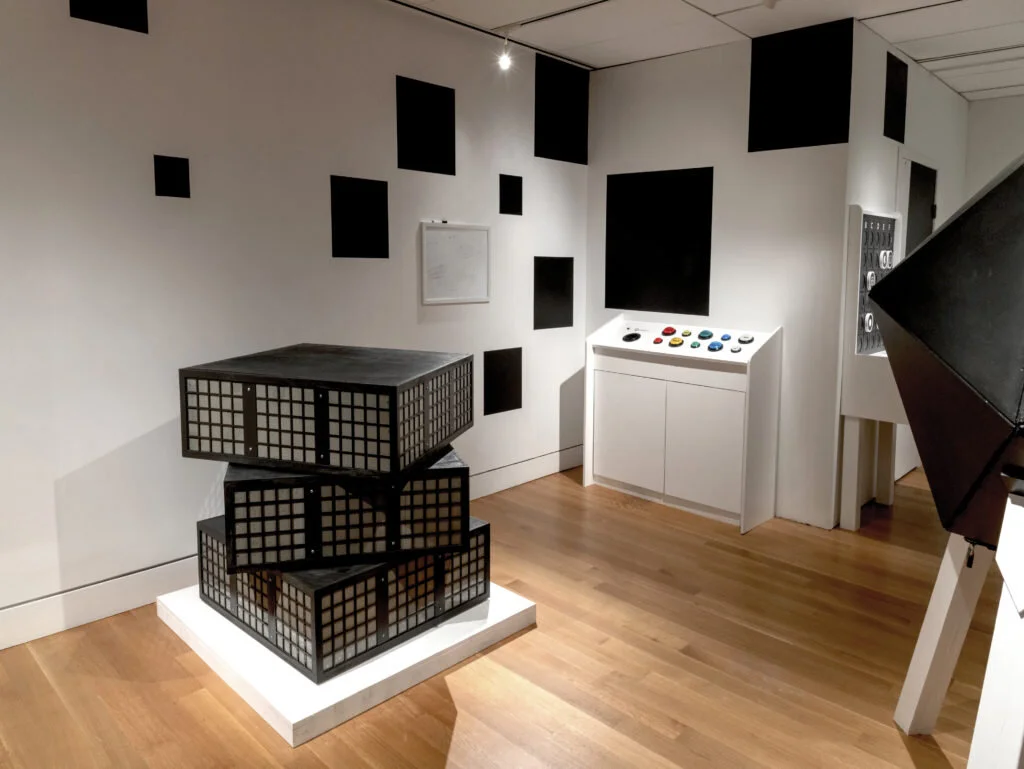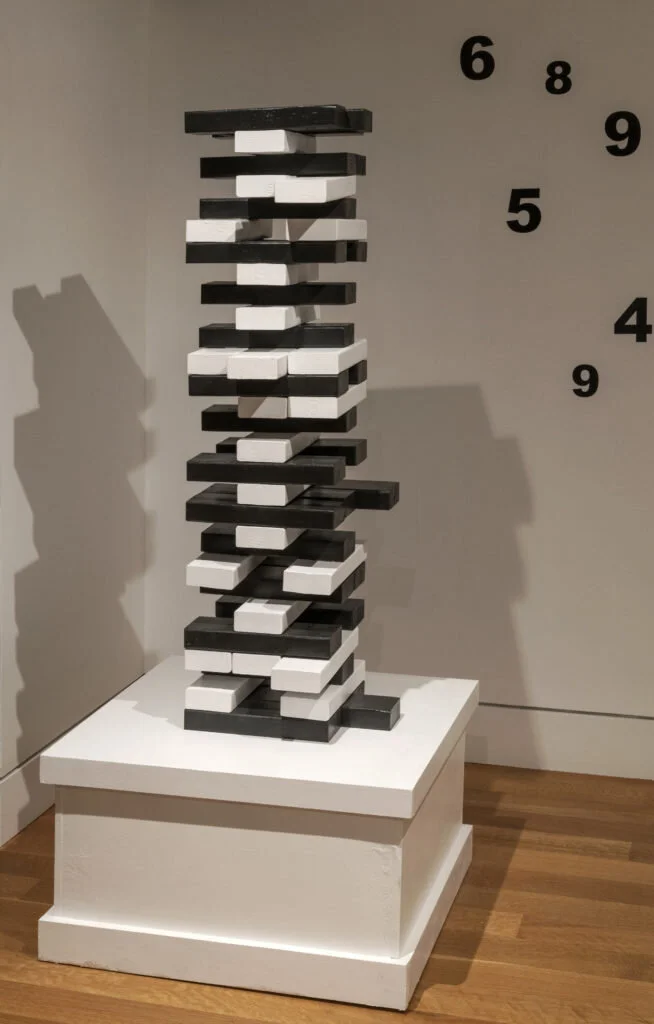Pause > System > Settings
Reconfiguring the Rules in Risa Puno’s Escape Room
Installation view, Risa Puno: Privilege of Escape.
Photo by Adam Reich, Courtesy of Creative Time
In 1971, philosopher John Rawls (1921-2002) published A Theory of Justice. One of the most significant tracts from this seminal text involves a now-famous thought experiment about “the original position.” Rawls maintained that our own biases, prejudices, special interests, and privileges blind us from objectively seeing justice.[1] In order to remove the various lenses that color how we see the world and how we advocate for our position in it, he devised an intellectual exercise that prompts participants to construct a society purely in their own interests while placing them behind a “veil of ignorance”, unaware of what social cards they have been dealt (i.e. class, race, gender, social status). He concluded that most participants would choose to design a world that mitigates the worst positions in society and makes the average position as advantageous as possible.
The spirit of Rawls’s experiment is comparable to the force animating Creative Time’s most recent public art project, Risa Puno’s The Privilege of Escape, at the Onassis Foundation in Midtown Manhattan. Arguably, Puno’s project is more compelling and successful than Rawls’s thought experiment because the fully immersive, participatory public art installation directly engages participants through games, riddles, and puzzles. Conceived, designed, and executed by the New York-based sculptor and installation artist Risa Puno in collaboration with Creative Time, the installation explicitly draws upon the format and appeal of commercial escape rooms while implicitly being informed by philosophical thought experiments, such as Rawls’s, that have probed concepts of identity, justice, privilege, and power. Puno adeptly plays with the metaphoric potential of gaming elements, language, and conditions to create an introspective experience that facilitates self-examination of privilege.
Installation view, Risa Puno: Privilege of Escape.
Photo by Adam Reich, Courtesy of Creative Time
Most escape rooms have an organizing theme that dictates everything from the sequence and phrasing of the clues to the overall set design to the sartorial expression of the staff interacting with participants. As such, The Privilege of Escape simulates the environment of a well-funded research facility, with guests treated as voluntary test subjects for a clinical study. This theme is reinforced by cold and sterile architectural elements, such as the polished stone floors, sliding glass door, and austere metal stairs. After being divided into two teams based on birth month, participants entered their respective chambers and began completing the experience, racing against the countdown clock.
The escape room featured a series of linked logic puzzles and visual riddles that drew on common elements (pictured below) found in a variety of games (dice, tumbler devices, spinning arrows, colored wheels, and balls).[2] Reflection upon the myriad gaming elements and rules from the experience illuminates how societal advancement is frequently predicated upon an individual’s ability to conform to pre-existing categories, norms, and standards. Additionally, Puno’s choice to incorporate well-known, twentieth-century children’s games (Connect Four, Battleship, Simon Says, Jenga, and Scrabble) underscores how games often instill values and lessons at formative ages across a wide swath of society.[3] Scholar Jules Prown classifies games under the heading of diversions, which encompasses toys, books, meals, and theatrical performances. Like all forms of material culture, games both reflect and reify dominant attitudes, values, and beliefs.[4]
Installation view, Risa Puno: Privilege of Escape.
Photo by Adam Reich, Courtesy of Creative Time
Another salient aspect of Puno’s project is that many of the tasks for the escape room involved sequencing, deciphering, and translating encrypted game pieces (as shown below). For instance, at one point team members had to properly arrange color-coded wooden blocks into a grid in order to deduce the correct numerical code, which in turn was used to unlock a box. These escape room exercises might be seen as standing in for the unspoken yet palpable codes of conduct—traditionally established by a white patriarchy—that exist to maintain the balance of power. Those belonging to non-dominant social groups or categories must detect, decode, learn, and model these proscribed modes of speech and action in order to be accepted and advance in most hierarchies.
Installation view, Risa Puno: Privilege of Escape.
Photo by Adam Reich, Courtesy of Creative Time
As members of our team desperately clamored to solve one of the remaining logic puzzles, the countdown clock reached zero and a side door opened to the debriefing room. Our team sullenly filed through the doorway to meet our opponents. We sat down in rows of chairs and listened to the actor ostensibly serving as the principal investigator of the staged behavioral study. She made use of a data-driven presentation with graphs and accompanying images, explaining that our group (Group B) only completed around 70% of the ordered exercises whereas Group A finished roughly 90% of the sequential tasks. However, the facilitator revealed that the playing (or working) conditions were not identical. In fact, there was one environmental variable in particular that made completing tasks in the Group B circuit more difficult and consequently more time-consuming.[5] The uneven playing conditions of the experience served as an important link in a metonymic chain that connected escape room riddles with the laws and policies dictating circumstances of public and private life. The guided comparative conversation about the challenges each team faced during the escape room modeled ways of approaching dialogues about social inequity, inherent advantages, personal struggles, and systemic barriers.
In sum, Puno deftly taps into the human impulses of curiosity, competition, and problem-solving that draws individuals to sign up for escape rooms. She recognized the potential of the live-action escape room format and its internal mechanics to be coopted and engineered to raise relevant questions about how to recognize, acknowledge, and talk about privilege in productive ways. Therein lies the power of The Privilege of Escape: long after participants have completed the escape room, the overall project supplies the base lexical scaffolding for fruitful exchanges about privilege and attendant issues. While meaningful reflection on the analogies embedded in the structure of the project is all but impossible during the race against the clock, participants inevitably revisit the experience mentally. In doing so, there is a likelihood for the masked metaphors in the game to create a heightened sense of awareness of one’s own privilege. Puno’s installation serves as a socially engaged prism, making visible the full spectrum of conditions, realities, restraints, and barriers that are normally concealed behind a blinding, white light.
The Privilege of Escape was recently extended through Sunday, August 18th. The project is located at Onassis USA, 645 5th Avenue, New York, NY 10022. The experience is free and open to the public, taking place Thursdays through Sundays. Advance tickets are required to participate. Those interested in signing up for the installation should visit Creative Time’s website.
Statement of Transparency: From January to May 2019, the author contributed in a limited administrative and research capacity to the development of The Privilege of Escape as a programming intern at Creative Time.
Installation view, Risa Puno: Privilege of Escape.
Photo by Adam Reich, Courtesy of Creative Time





